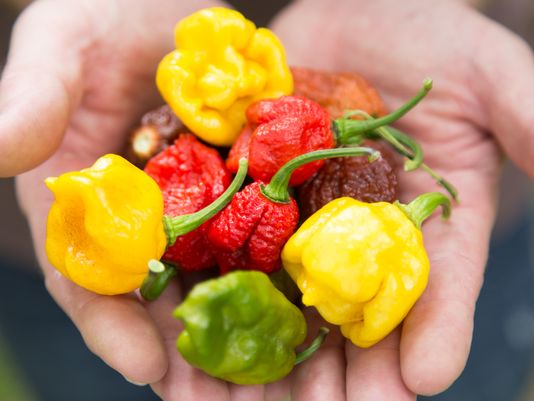It's part rock 'n' roll, part science experiment and pure adrenaline rush.
It's the short and squat purple pepper that could be the spiciest chili in the world.
"When you put one of these in your mouth, it's a whole 'nother ball game," Ronald "Troy" Primeaux says. "A bear is chasing you. You've just been in a car wreck. You just got caught speeding, and a cop is giving you a ticket. Your heart is pumping, and it lasts for about 30 minutes.
"Your body thinks it's going to die. You're not going to die."
Primeaux is working to stabilize this early generation pepper he's dubbed the Louisiana Creeper, a nod to Smokin' Ed's Carolina Reaper pepper that holds the title of Guinness World Record for hottest chili.
The 2009 graduate and current employee of the University of Louisiana at Lafayette is also working with the university to create an official Ragin' Cajun pepper that could include a line of products — such as hot sauce and pepper jelly — to go along with it.
"The university has had preliminary discussions about collaborating on a Ragin' Cajuns pepper and is exploring options," UL spokesman Charlie Bier said in an emailed statement. "We are very interested in growing our licensed consumable products, based on the success of our licensed burger, beers and coffee."
Primeaux has loved spicy food for as long as he can remember.
He says his mother fed him spicy gumbo through a bottle when he was just an infant. As a young child, he'd eat dozens and dozens of pickled jalapeno rings. As a teen, his family dared him to eat a whole habanero pepper, and he did so — with no regrets.
"Why do I love peppers so much?" Primeaux asks. "It's because they're beautiful, yet they can be deadly. They're rock 'n' roll. There's something dangerous about them that's thrilling like a roller coaster."
And he knows a thing or two about rock 'n' roll after playing guitar alongside local musicians Brother Dege and Tony Daigle for about 10 years.
But Primeaux has set aside his guitar for something he finds just as exhilarating — creating the hottest pepper in the world.
Primeaux learned the ins and outs of growing and crossing peppers from professors he met while studying nursing at UL.
He grew peppers for the first time in 2004 and became intrigued by the "mystery of the new varieties." He crossed his first peppers the next year that resulted in the 7 Pot Primo. As he worked toward his nursing degree, Primeaux continued to experiment with peppers and worked to stabilize his new creations.

But with a 3.8 grade point average and only two semesters left, Primeaux surprised his friends and family in 2007 by switching his major from nursing to sustainable agriculture.
"The bad thing about nursing is that you take it all home with you. It's a lot to carry around," Primeaux says. "It takes somebody who can give a lot of themselves. I switched to plants because if you kill a plant, it's not that big of a deal. And they don't sh-- on you, either."
Primeaux graduated in 2009 and continued growing peppers as he worked day jobs in and outside of his field. He currently conducts watershed testing for the university.
To create a name for himself, Primeaux crosses peppers of his own creation by a process best described as artificial insemination — using the male reproductive parts of a particularly hot pepper plant to fertilize a particularly hot female plant of a different variety.
He keeps each of the 120 or so pepper plants in his Lafayette backyard garden from unintentionally cross pollinating by covering plants in mesh bags. He meticulously labels and tracks every variable for each of his pepper plants.
His larger crop of about 200 peppers were lost during the recent flooding on his mother's land in Indian Bayou. Primeaux would have sold the 100,000 seeds he would have harvested from those peppers to growers for $7.99 for 20 seeds.
The Louisiana Creeper is a cross between two of Primeaux's creations, the 7-Pot Primo and the Big Black Mama or BBM.
Primeaux made the 7-Pot Primo by crossing a Trinidad 7-Pot chili — named because it can season seven pots of stew — with a Bhut Jolokia, which is better known as the ghost pepper. He created the BBM by crossing the Bangladesh Naga Morich chili and the Trinidad Douglah chili.
"I'm still selecting different attributes," he says. "I'll cut open a pepper and check out the physical attributes and judge the look and smell and all of that of the plant to get what I want."
It's difficult to determine exactly what the hottest pepper in the world is because there is no single governing authority that measures the spiciness of chili peppers.
Individual chili varieties have been tested by different universities but haven't been tested against one another at the same university.
The Carolina Reaper rates an average of 1.57 million Scoville Heat Units according to tests conducted by Winthrop University in South Carolina and holds the Guinness World Record for hottest chili.
The 7-Pot Primo rates an average of 1.4 million SHU, according to tests conducted by the Chile Pepper Institute at New Mexico State University.
By comparison, a habanero pepper is typically between 100,000 and 350,000 SHU, and a jalapeno pepper is between 1,000 and 20,000 SHU.
Primeaux hopes his Louisiana Creeper and Ragin' Cajun peppers will have an average of 2 million SHU or better. It's a possibility, considering a single Carolina Reaper pepper came in at 2.2 million SHU during university testing to determine the average.
And for Primeaux, creating alarmingly spicy peppers is just the latest venture in a quest to leave his mark on the world.
"I didn't intend to create the world's hottest pepper — arguably the world's hottest pepper," he says. "It's something I stumbled upon with a lot of passion, a little know-how and a lot of luck."


